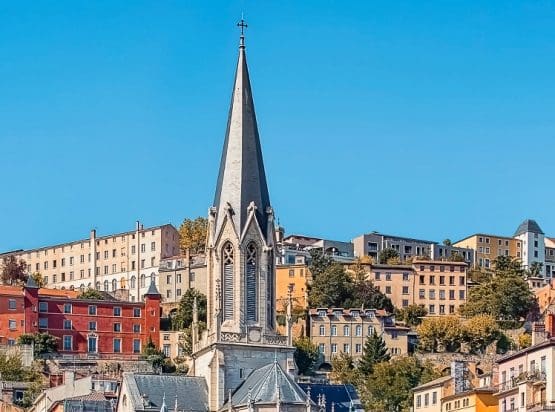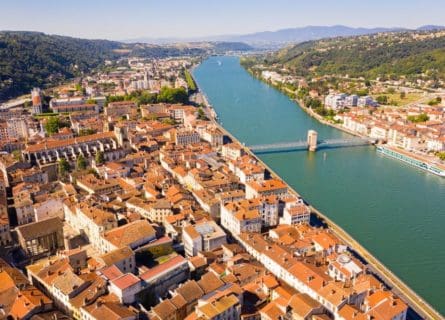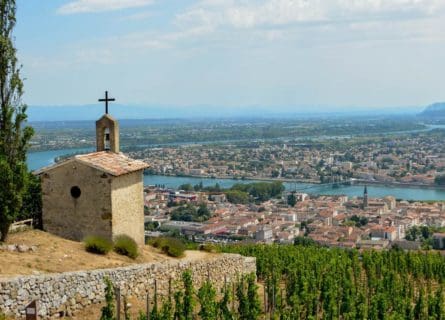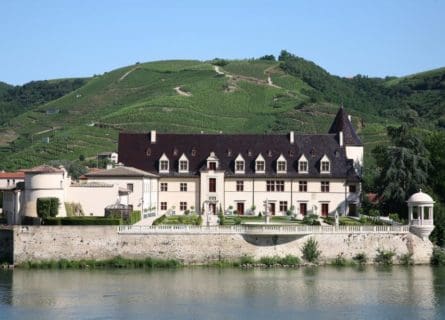Uncover Lyon's vibrant flavors and culinary gems with our expert guides. Plan an unforgettable trip now!
Read more
EXPLORE ALL OUR RHôNE VALLEY WINE REGION GUIDES
Last updated: April 4, 2025
For many oenophiles and collectors, Syrah reaches the summit of perfection in Côte Rôtie. It is a magical place; terraced vineyards cling to the western slopes of the Northern Rhone Valley, overshadowing the pretty village of Ampuis. Like the great wine villages of Burgundy, Côte Rôtie’s fame derives from a potent combination of first-class terroir, climate, and variety, resulting in exquisite and long-lived wines.
Today, aficionados speak of the single vineyards La Mouline and La Turque with the same excitement and reverence that Chambertin and Latour receive. High times indeed for the winegrowing community of Côte Rôtie.
Discover More About French Wine

In the last century BC, Julius Caesar conquered the vast province of Gaul (France). One of the most important settlements, militarily and strategically, was Lugdunum (Lyon). Founded in 43 BC, Lugdunum became Rome’s gateway to the Alps and the Rhone Valley: a rich and fertile land that attracted traders from across the empire.
Before long, people were propagating vines along the vertiginous slopes of the northern Rhone, producing sweet wines (often adulterated with herbs and sugar) that bore little resemblance to the powerfully structured reds of today.
Rise of the Burgundians and Franks
The Western Roman Empire collapsed in the 5th century AD; Rome’s former territories were under siege from all directions. The Burgundians captured the city of Vienne (located just north of Côte Rôtie) in 438, but the Franks took it over in the 6th century.
During the Middle Ages, the Frankish Merovingian and Carolingian dynasties managed to pacify most of France, although the Lombards and Moors attacked Vienne several times. Nevertheless, in the 9th century, the Frankish king Charles II the Bald ‘gifted’ the Northern Rhone to Comte Boso of Provence. It subsequently became part of the Holy Roman Empire in 1032.
Lyon’s Emergence as a Commerce and Viticulture Hub
In the 1400s, Lyon and the Rhone Valley had become major centers of commerce and viticulture; the arrival of the movable type in 1473 set Lyon on the path to becoming Europe’s foremost publishing center, contributing greatly to the area’s prosperity and renown.
By the mid-18th century, Lyon’s silk weavers transformed the city into the silk-weaving capital of Western Europe. Meanwhile, improved transport links between the Rhone and northern France allowed Côte Rôtie to capture the attention of the Parisian bourgeoisie; England’s upper classes were no less impressed with “Cote-Roty,” particularly the 1st Earl of Bristol John Hervey. They were shipped to northern Europe in gigantic clay vessels similar to amphoras.
By the 19th century, however, the use of barrels and bottles had become widespread.
The Rise of Côte Rôtie
A century later, Lyon had tripled in size, and the Rhone was a thriving viticultural powerhouse. Yet, although the region did recover from the phylloxera epidemic of the late 1800s, appellations such as Côte Rôtie lacked the international recognition afforded to Bordeaux, Burgundy, and Champagne. Marginalized by a collective myopia on the part of the big spenders, this part of the world remained an insider secret.
However, the great winemaker and skilled marketeer Marcel Guigal has done much to put Côte Rôtie on the fine wine map. His proselytizing has paid dividends; prices continue to rise, and the area under vine has increased significantly over the past five years.

Côte Rôtie is the first major appellation you’ll encounter when traversing the majestic Northern Rhone. Situated in south-eastern France, Côte Rôtie’s vineyards are just south of Vienne, approximately 35 kilometers from Lyon.
Although the area under vine is larger than 20 years ago, Côte Rôtie is still a small (just over 500 hectares under vine) viticultural zone. Only the villages of Ampuis, Saint-Cyr-sur-le-Rhône, and Tupin-et-Semons are entitled to market wines under the appellation banner. Strict terroir delineation is at the heart of the winegrowing culture in Côte Rôtie.
Climatic Challenges
Vineyards thrive in the region’s continental climate, with warm (but rarely excessively hot) summers and cold winters. It is noticeably cooler and more inclement than the southern Rhone, particularly in winter.
For example, Côte Rôtie typically receives about 920mm of rainfall a year, while Avignon in the south is lucky if it surpasses the 550mm mark. However, excessive rainfall can be an issue during flowering and harvest time. Therefore, growers must constantly be vigilant to harvest a good crop in Côte Rôtie, particularly concerning fungal diseases like powdery mildew.
The Unique Terroir of Côte Rôtie’s Steep Slopes
Nevertheless, the finest sites in the appellation boast an exceptional terroir that is the envy of all across the Rhone Valley. These breathtakingly steep terraces, lined with free-draining metamorphic rock, reflect the sun’s heat into the vine canopy. This helps Syrah reach good phenolic maturity levels, even in cooler years.
The southeast-facing aspect also ensures that the sun exposes most vines all day. A visit to Côte Rôtie during harvest time offers a spectacular sight, with the need for pulleys and even monorails to transport boxes of grapes from these incredibly steep slopes to the winery.
Côte Blonde and Côte Brune
Historically, growers have split Côte Rôtie into two distinct sub-zones within the appellation: Côte Blonde and Côte Brune. There is no shortage of locals who will wax lyrical about both terroirs’ differences and relative merits.
However, all agree that a south-facing incline just south of Ampuis hosts the Côte Blonde, while the Côte Brune lies to the north of the town on a southwest-facing slope. Additionally, Côte Blonde is renowned for its granite soils, featuring varying levels of sand, slate, and limestone in the bedrock.
In contrast, the terroir of Côte Brune is cooler and more robust – schist and heavier clay soils predominate, with iron deposits in certain areas.
Stylistic Distinctions and the Art of Blending
This polarity inevitably leads to stylistic differences once the wines are in bottle. During a blind tasting, critics usually identify which wines are from Côte Blonde; the terroir produces a very elegant expression of the Syrah grape, with aromatic intensity and wonderful freshness.
Côte Brune is another matter entirely – powerfully structured; the wines are more firm and perhaps slightly unforgiving in their youth. One school of thought advocates blending grapes from these two subregions to enhance complexity, creating a superior wine.

What is a quintessential Côte Rôtie wine? Critics and writers would traditionally speak of finesse and elegance – a ‘Burgundian’ style of Syrah with wonderful perfume and fine tannins. In their youth, the wines often show notes of red berries and sweet spices, complemented by white pepper on the finish.
These supremely elegant reds were traditionally made as gently and sensitively as possible: Many producers still favor a mixture of whole bunches and crushed grapes in the vat, including a percentage of stems. The must is then fermented in (most typically) old oak vats and/or concrete, with temperatures rising above 95 Fahrenheit.
This produces complex and deeply colored reds, although excessive heat can encourage burnt, jammy flavors. For that reason, many wineries prefer to vinify in stainless steel, using temperature control to enhance fruit flavor and freshness in Syrah.
The Impact of Marcel Guigal on Côte Rôtie Winemaking
Historically, maturing Côte Rôtie in old barrels resulted in a minimum pickup of oak-derived aromas. Then Marcel Guigal changed everything. Untroubled by the controversy surrounding his winemaking philosophy, Guigal started aging certain cuvées in a new French barrique, sometimes for over two years.
These are wines for collectors who worship richness and power, with vanilla, cedarwood, tobacco, and chocolate aromas. However, whether such wines authentically express Côte Rôtie’s terroir is debatable. But, as ever, personal preference is the ultimate judge.
The Role of Viognier in Côte Rôtie Blends
According to the appellation rules, growers can include up to 20% of the white grape Viognier in the final blend. Classically, producers used Viognier to add perfume and freshness to the wines, a practice that several major houses still maintain. Few producers use more than 5% to enliven their already brilliant wines. As a result, an excess of Viognier in the vat can spoil the style.
To blend, or not to blend? That is the question. The Riojans understand this dilemma all too well: blending versus terroir expression has become something of a culture war issue in the region, arousing strong feelings and passionate debate. Like Champagne, there is a tradition of blending wines from different subregions and terroirs in Rioja, creating something greater than the sum of its parts.
“There is a current obsession with single-vineyard wines that leads to an excess of offer – marketing is often the real reason why some single-vineyard wines exist,”
observed José Urtasun, owner of Remirez de Ganuza.
Producers in Côte Rôtie are having similar discussions: should the appellation maintain its longstanding tradition of mixing and matching terroirs, or is the Burgundian approach more relevant in the modern age?
Marcel Guigal’s Emphasis on Terroir and Single Vineyard Wines
Marcel Guigal represented one side of the argument. Indeed, Guigal was never one to equivocate about the importance of celebrating terroir. On the contrary, he believed that Côte Rôtie should closely emulate Burgundy by stressing the primacy of single vineyards and the synergy between variety and site. He has since been vindicated – Guigal’s single-vineyard wine collection is among the most expensive and sought-after being made today.
Traditional Blending Practices
However, there are still winegrowers who firmly reject this paradigm. In the 20th century, merchants commonly blended wines from Blonde and Brune to forge a ‘unified’ Côte Rôtie. Some still follow this path, arguing that the fetishization of single vineyards is undiluted narcissism.
However, the cult of terroir expression has increasingly seduced many growers, leading them to reference the vineyard name on the label more frequently. Les Grandes Places and La Vialliere stand as just two climats held in great esteem in the zone. Unlike the Côte d’Or, there is no official stratified hierarchy of vineyards in the Rhone.
Single Vineyard Wines in Côte Rôtie
Unofficially, most would concede that the best single vineyards are located immediately above Ampuis. La Mouline, La Landonne, and La Turque have become legendary among collector circles, with prices to match. La Mouline, a Guigal brand since 1966, could be described as Côte Rôtie’s answer to La Tache.
Complex and unbelievably refined, La Mouline will age and improve in bottle for many decades. Its sumptuous texture and an ethereal bouquet of violets, thyme, blackberry, and coffee have no equal in the Northern Rhone.
Blended vs. Single Vineyard Wines
These wines should be celebrated as representing Syrah at its most refined and complex. Yet it would be a mistake to sanctify these single-vineyard expressions at the expense of blended styles. Both are relevant to consumers today – what people want, above all, is freedom of choice. Plus ça change.
Viognier comes from the northern Rhône valley AOC of Condrieu and is where its most famous white wines are produced.
Find out moreSyrah is dark-skinned and perhaps the most underrated of the 'noble' red grape varieties.
Find out moreMost visitors to Côte Rôtie head north to the city of Lyon after dark, where memorable dining is guaranteed. Indeed, they don’t call Lyon, France’s gastronomic capital, for nothing – every conceivable type of restaurant is up for grabs, including classic brasseries, formal restaurants, and Michelin-starred extravaganzas.
Yet many foodies prefer the informality of Lyon’s many Bouchons: small, friendly bistros that serve traditional dishes in a relaxed environment. Hearty entrées include boudin blanc (veal sausage) and gras double (tripe – an acquired taste!).
A Gastronomic Guide to the Cuisine of the Rhone Valley: Read more
If you would like us to customize an exclusive luxury tour, contact us and let us know your travel plans. We offer luxury food and wine tours for private groups of a minimum two guests. In addition, all of our private, chauffeured tours are available year-round upon request.

